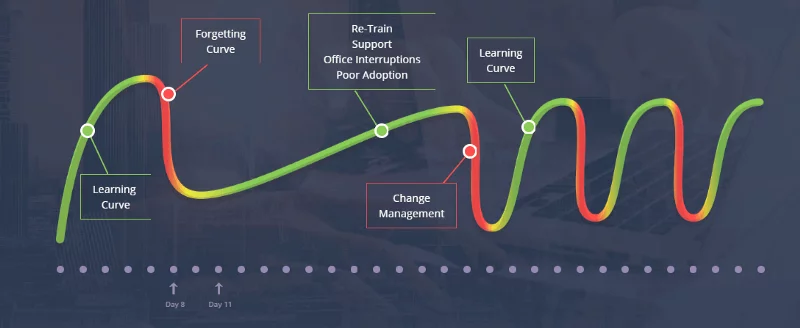The capabilities of enterprise technology are evolving at an accelerating pace. Is your approach to employee training able to keep up?
In the modern digital workplace, where the vast majority of tasks are performed on online platforms, outdated methods of training are a major barrier to success. But even organizations that attempt to take a more progressive approach often prioritize the wrong methods.
The consequences of deploying inadequate training extend far beyond a lack of competency and limited productivity. Employee frustration, stress, and burnout are plaguing a growing number of businesses.
It’s time to revamp your employee training model. It’s time to initiate “learning in the flow of work.”
Mapping the evolution of employee training
The development of employee training methods generally corresponds to the emergence of new technology. As enterprise tools become more advanced, training must be equipped to cover a broader range of processes.
The problem arises when training managers attempt to apply outdated learning models to new platforms and processes.
Dive Deeper: How to Rewrite Your Training Definition to Fit the Digital Age
What counts as an “outdated” training method?
Training 1.0 and even 2.0 are not equipped to prepare employees for success in the digital workplace.
Training 1.0
The first iteration of training techniques includes traditional classroom sessions, in-person demonstrations, dense instruction manuals, and  webinars. They require employees to put their work aside for the duration of the training period, retain a lot of new information, then successfully put it into practice on their own.
webinars. They require employees to put their work aside for the duration of the training period, retain a lot of new information, then successfully put it into practice on their own.
While in the past, listening to an explanation or watching a one-time tutorial might have been adequate for learning offline processes, there’s no way such an approach could cover all of the complexities and nuances on contemporary software.
Training 2.0 The same goes for Training 2.0. While this next generation of training tools actually includes digital solutions — such as LMS apps, gamification, and other e-learning models — it still requires employees to complete training separate from their actual work.
They’re still required to recall all of the new information once it’s time to actually use new processes.
The forgetting curve is steep
Hermann Ebbinghaus came up with the learning curve 100 years ago. According to his theory, people rapidly lose their memory of new information over a short period of time.
He estimated that if you can absorb 100% of new information in one day, you will forget 50%-80% of what you learn each day afterward. After 30 days, you’ll retain just 2%-3% of the information.
By Ebbinghaus’s definition, the learning curve is more easily understood as a forgetting curve, illustrated below.

The main reason traditional approaches to training are ill-suited for the digital era is there is too much new information, and it’s impossible to retain it all. Ultimately, the time and resources devoted to training (when your employees could have been working) go to waste.
Learning in the flow of work eliminates the ‘forgetting curve’
Josh Bersin, world-renowned HR, talent, and learning analyst, says the world of corporate training has entered a new paradigm. Training  techniques that don’t occur in the context for which they are intended will automatically fall short.
techniques that don’t occur in the context for which they are intended will automatically fall short.
In the digital era, where virtually all of employees’ work is performed on digital systems and apps, learning must occur within the digital system itself. To this end, Bersin coined the term “learning in the flow of work.”
There are many benefits of training that enables learning in the flow of work. For one thing, it eliminates the gap between theory and practice, which automatically engages your memory and accelerates learning. Second, it’s far more efficient, as it doesn’t require extra time dedicated to lengthy training sessions.
The sum effect of these two benefits is greater time-to-competency, long-term knowledge retention, and instant productivity.
Like what you’re reading? Subscribe to the blog for fresh insights delivered right to your inbox!
Contextual learning enables learning in the flow of work
If learning in the flow of work defines Training 3.0, digital solutions that offer contextual learning actually make it happen. Josh Bersin cites WalkMe as a key enabler of learning in the flow of work for this reason.
Digital training solutions that provide contextual learning, such as WalkMe’s Digital Adoption Platform, have algorithms that analyze a broad range of context-sensitive factors in order to provide tailored, real-time walk-throughs and support.
Among many others, these factors can include the specific actions the user is taking, their position in the company, the goals of the department, and any number of predefined parameters.
Contextual learning is the ultimate facilitator of learning in the flow of work, as it completely eliminates the need to pull employees away from their desks to complete training. Instead, learning is 100% experiential. Onscreen prompts that guide the user through processes step-by-step lets them learn while actually completing the tasks efficiently.
That means fast software learning is accessible to all users, regardless of prior experience on a platform.
Now you can say goodbye to the forgetting curve and make the ramping up process nearly instant.
What’s your outdated training costing you?
Old school training methods simply don’t stick in the digital age. Clinging to these models will cost you in several key ways.
Time lost to training, poor knowledge retention, diminished productivity, a high volume of support tickets, and a whole lot of mistakes can deal a major blow to overall business performance.
On top of that, employee frustration, burnout, and low morale can fuel turnover and disengagement.
It’s time to cross over into the new paradigm.
WalkMe’s Digital Adoption Platform (DAP) transforms the user experience in today’s overwhelming digital world. Using artificial intelligence, engagement, guidance, and automation, WalkMe’s transparent overlay assists users to complete tasks easily within any enterprise software, mobile application or website. Discover how a DAP can revolutionize your business.

